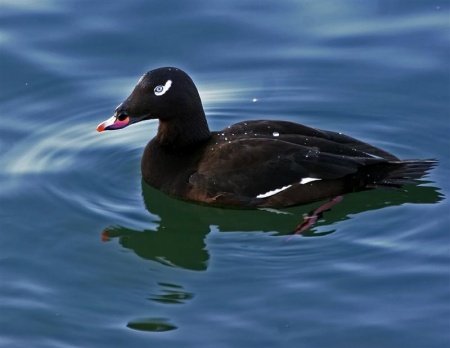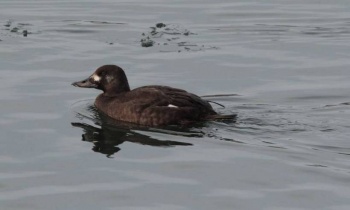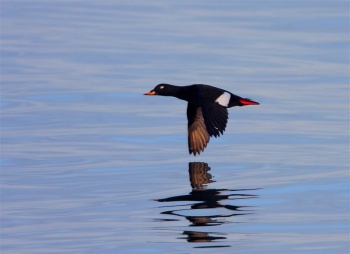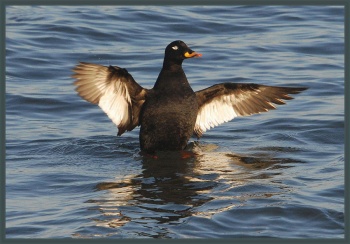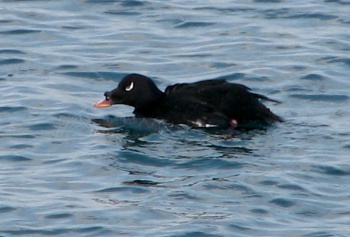(Picture showing underwing & bill. Attempt to disguise some copied text. References updated) |
(Picture of Subspecies ''stejnegeri''.) |
||
| Line 12: | Line 12: | ||
[[Image:Velvet_Scoter2.jpg|thumb|350px|right|Female "Velvet Scoter", Eurasian ''fusca'' <br />Photo by {{user|Gwynn|Gwynn}}<br />[[Austria]]]] | [[Image:Velvet_Scoter2.jpg|thumb|350px|right|Female "Velvet Scoter", Eurasian ''fusca'' <br />Photo by {{user|Gwynn|Gwynn}}<br />[[Austria]]]] | ||
====Flight==== | ====Flight==== | ||
| − | In flight, it shows a white patch on the rear of the wing. | + | In flight, it shows a white patch on the rear of the wing. |
| + | |||
'''Female''' brown and somewhat scaly looking, with two pale spots in the head, one on the [[Topography#Heads|auriculars]], one between eye and bill. | '''Female''' brown and somewhat scaly looking, with two pale spots in the head, one on the [[Topography#Heads|auriculars]], one between eye and bill. | ||
====Notes on distinguishing males of the subspecies==== | ====Notes on distinguishing males of the subspecies==== | ||
| Line 33: | Line 34: | ||
The subspecies ''deglandi'' has in the past and is increasingly again recognized as a full species (for example by the British BOURC), which would keep the name of White-winged Scoter; subspecies ''fusca'' would then become Velvet Scoter. Subspecies ''stejnegeri'' would be a subspecies of ''M. deglandi'' if BOURC is followed, but has also sometimes been considered a full species. Opus follows the developments in the worldwide checklists. | The subspecies ''deglandi'' has in the past and is increasingly again recognized as a full species (for example by the British BOURC), which would keep the name of White-winged Scoter; subspecies ''fusca'' would then become Velvet Scoter. Subspecies ''stejnegeri'' would be a subspecies of ''M. deglandi'' if BOURC is followed, but has also sometimes been considered a full species. Opus follows the developments in the worldwide checklists. | ||
==Habitat== | ==Habitat== | ||
| + | [[Image:Scooter bf.jpg|thumb|350px|right|Subspecies ''stejnegeri''<br />Photo by {{user|DaninJapan|DaninJapan}}<br />Misawa port, Aomori-Ken, [[Japan]], March 2006]] | ||
Breeds around fresh water bodies near boreal forests and arctic tundra; sometimes far from the coast. | Breeds around fresh water bodies near boreal forests and arctic tundra; sometimes far from the coast. | ||
Revision as of 14:47, 25 May 2015
- Melanitta fusca
Includes Velvet Scoter
Identification
51-58cm
Male
- Black overall plumage
- White 'tear drop' just behind the eye
- Long yellow bill
- Thick neck
- Pointed tail
Flight
In flight, it shows a white patch on the rear of the wing.
Female brown and somewhat scaly looking, with two pale spots in the head, one on the auriculars, one between eye and bill.
Notes on distinguishing males of the subspecies
- deglandi: clear knob at the base of the bill, with the yellow-orange part relatively short, so that the eye looks set further back on head than fusca. The white around the eye is shaped as a checkmark, pointed up at the rear end. The colored part of the bill is orange with the top parts looking yellow. The crown is highest in front of the eye. When seen well, flanks will be brown in contrast to black back and breast.
- stejnegeri: Head shape closer to eider in shape, with a long, sloping forehead. White around eye similar to or longer than deglandi. It has a clear knob on the bill, further forward than deglandi, and the colored parts are mostly red with yellow "lipstick" below. Flanks are black.
- fusca: the least knob on the bill, and the least white around and behind the eye; almost no white above the eye. The colored section of the bill is yellow and relatively long and the distance from the base of that to the eye is short, producing the impression that the eye is positioned relatively far forward on the head. The crown looks highest above the eye.
Distribution
Breeds in northern areas around the globe, such as Scandinavia (especially Sweden and Norway), northern Asia, and northern North America.
Migrates in winter to areas that have coastal open water, for example in Europe will be found from Norway to Spain and east to the Caspian Sea.
Taxonomy
Subspecies
Three subspecies are currently recognized[1]:
- M.f. deglandi (White-winged Scoter) occurs in North America and includes dixoni which is no longer recognized.
- M.f. stejnegeri is found in Eastern Asia. This form is also sometimes proposed for recognition as a full species, Asian White-winged or Stejneger's Scoter.
- M.f. fusca is found in Europe and western Asia.
The subspecies deglandi has in the past and is increasingly again recognized as a full species (for example by the British BOURC), which would keep the name of White-winged Scoter; subspecies fusca would then become Velvet Scoter. Subspecies stejnegeri would be a subspecies of M. deglandi if BOURC is followed, but has also sometimes been considered a full species. Opus follows the developments in the worldwide checklists.
Habitat
Breeds around fresh water bodies near boreal forests and arctic tundra; sometimes far from the coast.
Outside of the breeding season, they are to be found in coastal waters, often near shellfish beds
Behaviour
Diet
Their diet includes shellfish, crabs, sea urchins, fish, insect larvae and plants.
Breeding
They build a lined nest on the ground near lakes or rivers, in woodland or tundra. The clutch consists of 7-9 eggs.
Vocalisation
<flashmp3>Melanitta fusca (song).mp3</flashmp3>
Listen in an external program
References
- Clements, J. F., T. S. Schulenberg, M. J. Iliff, D. Roberson, T. A. Fredericks, B. L. Sullivan, and C. L. Wood. 2014. The eBird/Clements checklist of birds of the world: Version 6.9., with updates to August 2014. Downloaded from http://www.birds.cornell.edu/clementschecklist/download/
- DUDLEY et al. 2006. The British List: A Checklist of Birds of Britain (7th edition). Ibis 148:526–563 with online updates to 2009
- R Strack 2010. Fløjlsænder. Fugle i Felten, #1, January 2010, pg 6-7. (in Danish)
- Handbook of the Birds of the World Alive (retrieved May 2015)
- Birdweb.org
- Wikipedia
Recommended Citation
- BirdForum Opus contributors. (2024) White-winged Scoter. In: BirdForum, the forum for wild birds and birding. Retrieved 18 April 2024 from https://www.birdforum.net/opus/White-winged_Scoter




